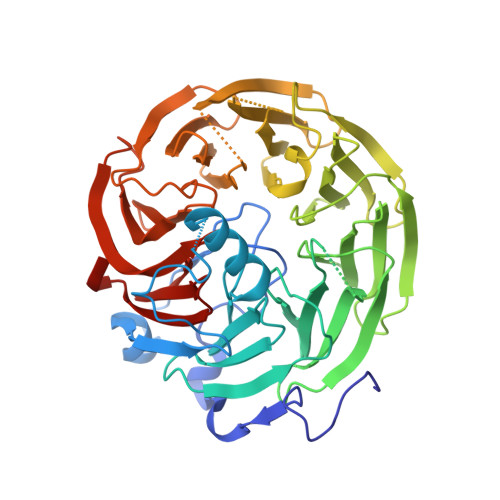Reaction mechanism of tetrathionate hydrolysis based on the crystal structure of tetrathionate hydrolase from Acidithiobacillus ferrooxidans.
Kanao, T., Hase, N., Nakayama, H., Yoshida, K., Nishiura, K., Kosaka, M., Kamimura, K., Hirano, Y., Tamada, T.(2020) Protein Sci 30: 328-338
- PubMed: 33103311
- DOI: https://doi.org/10.1002/pro.3984
- Primary Citation of Related Structures:
6L8A, 7CQY - PubMed Abstract:
Tetrathionate hydrolase (4THase) plays an important role in dissimilatory sulfur oxidation in the acidophilic iron- and sulfur-oxidizing bacterium Acidithiobacillus ferrooxidans. The structure of recombinant 4THase from A. ferrooxidans (Af-Tth) was determined by X-ray crystallography to a resolution of 1.95 Å. Af-Tth is a homodimer, and its monomer structure exhibits an eight-bladed β-propeller motif. Two insertion loops participate in dimerization, and one loop forms a cavity with the β-propeller region. We observed unexplained electron densities in this cavity of the substrate-soaked structure. The anomalous difference map generated using diffraction data collected at a wavelength of 1.9 Å indicated the presence of polymerized sulfur atoms. Asp325, a highly conserved residue among 4THases, was located near the polymerized sulfur atoms. 4THase activity was completely abolished in the site-specific Af-Tth D325N variant, suggesting that Asp325 plays a crucial role in the first step of tetrathionate hydrolysis. Considering that the Af-Tth reaction occurs only under acidic pH, Asp325 acts as an acid for the tetrathionate hydrolysis reaction. The polymerized sulfur atoms in the active site cavity may represent the intermediate product in the subsequent step.
Organizational Affiliation:
Department of Biofunctional Chemistry, Division of Agricultural and Life Science, Graduate School of Environmental and Life Science, Okayama University, Okayama, Japan.















